BLO1105 Business Law: Analyzing Separation of Powers & Contracts
VerifiedAdded on 2023/04/21
|13
|3064
|490
Report
AI Summary
This assignment provides a comprehensive analysis of the doctrine of separation of powers within the Australian constitutional framework, detailing the legislative, executive, and judicial branches and their respective roles. It further examines the principles of contract law, including offer, acceptance, consideration, capacity, legality, and mutual consent, referencing relevant case laws such as Masters v Cameron. The assignment addresses the issue of whether a contract exists between Events Management Ltd and Rigby Corporate Function Planners Pty Ltd, and whether any breach has occurred. Desklib provides this assignment and many other resources like past papers and solved assignments for students.
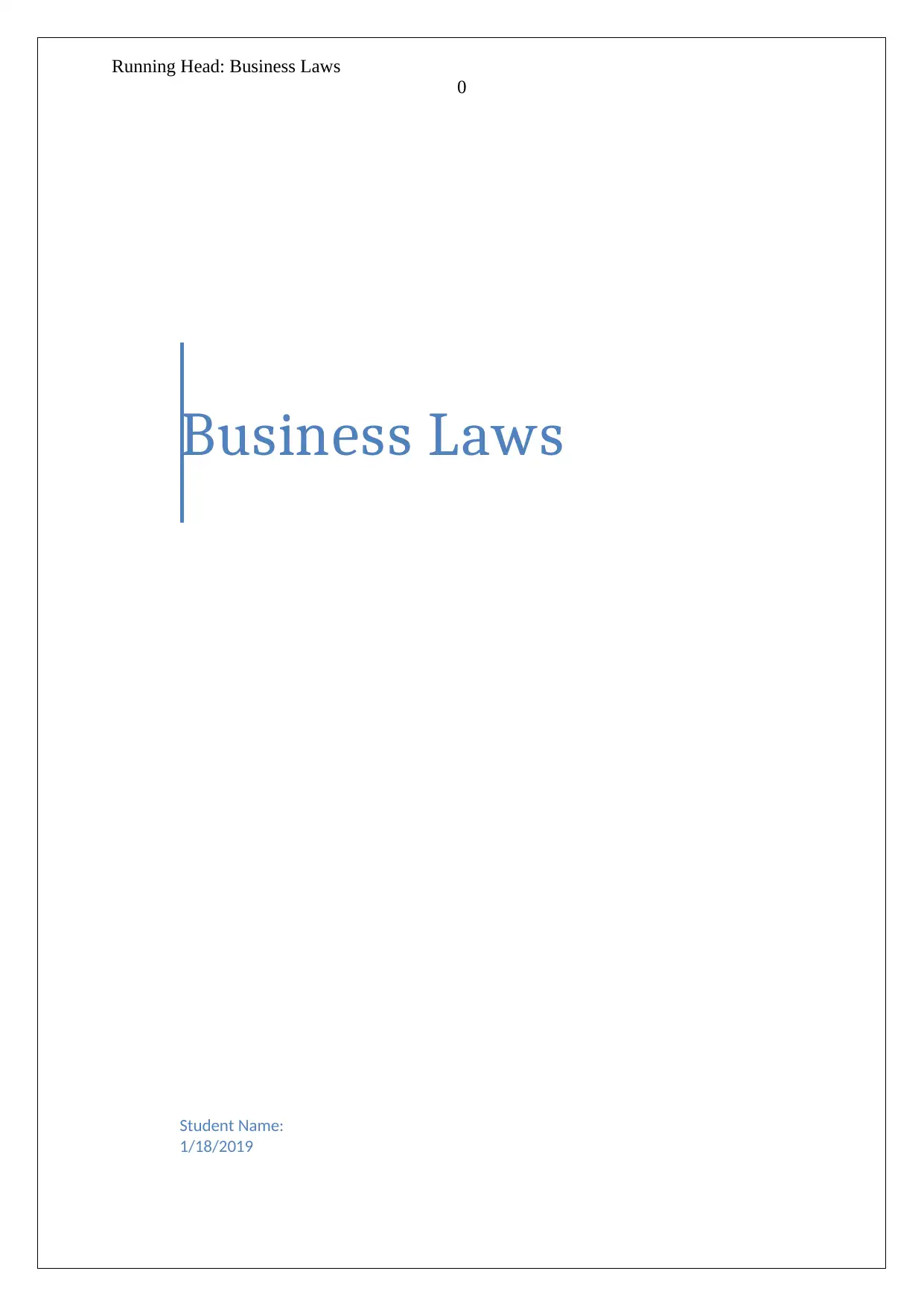
Running Head: Business Laws
0
Business Laws
Student Name:
1/18/2019
0
Business Laws
Student Name:
1/18/2019
Paraphrase This Document
Need a fresh take? Get an instant paraphrase of this document with our AI Paraphraser
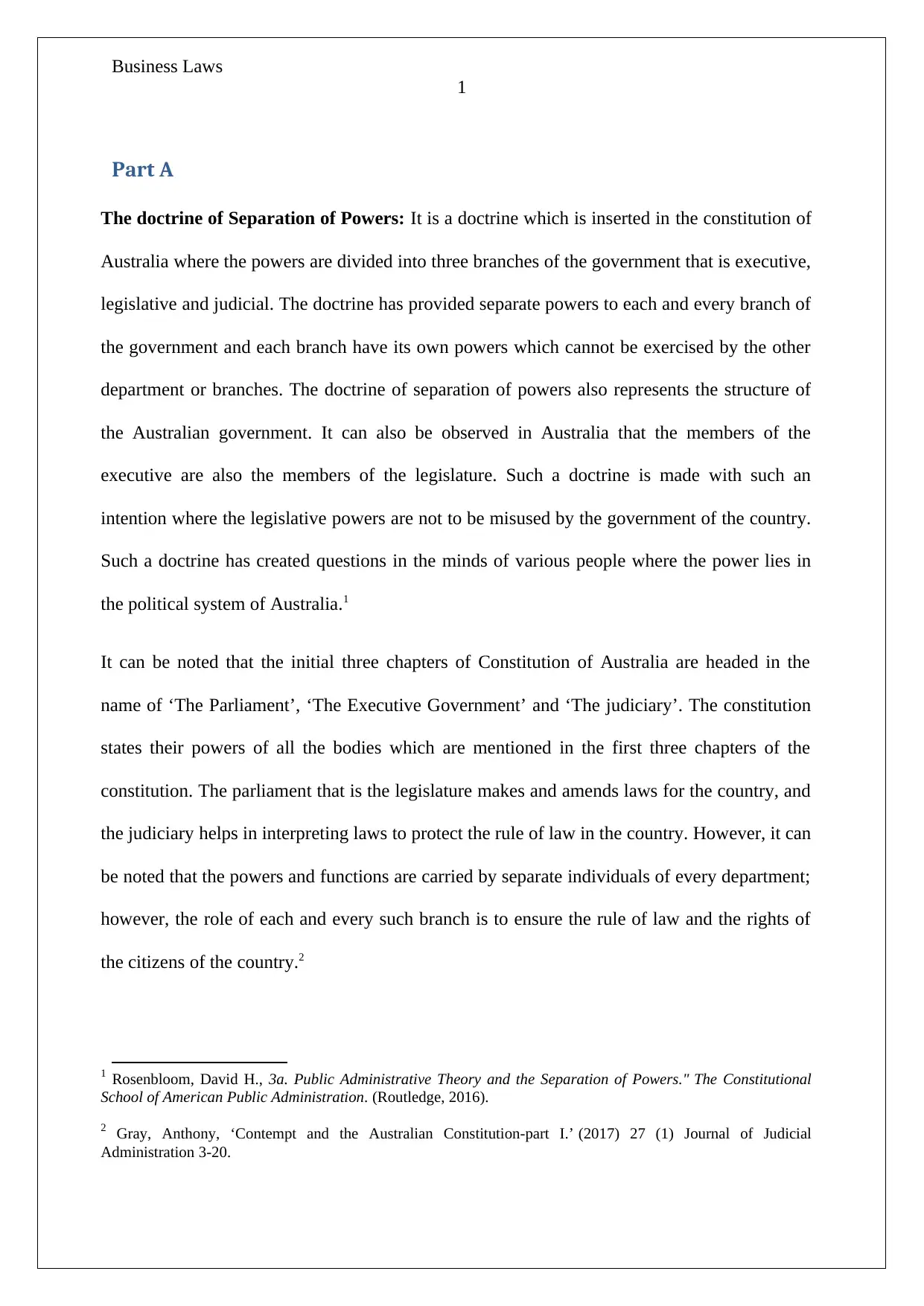
Business Laws
1
Part A
The doctrine of Separation of Powers: It is a doctrine which is inserted in the constitution of
Australia where the powers are divided into three branches of the government that is executive,
legislative and judicial. The doctrine has provided separate powers to each and every branch of
the government and each branch have its own powers which cannot be exercised by the other
department or branches. The doctrine of separation of powers also represents the structure of
the Australian government. It can also be observed in Australia that the members of the
executive are also the members of the legislature. Such a doctrine is made with such an
intention where the legislative powers are not to be misused by the government of the country.
Such a doctrine has created questions in the minds of various people where the power lies in
the political system of Australia.1
It can be noted that the initial three chapters of Constitution of Australia are headed in the
name of ‘The Parliament’, ‘The Executive Government’ and ‘The judiciary’. The constitution
states their powers of all the bodies which are mentioned in the first three chapters of the
constitution. The parliament that is the legislature makes and amends laws for the country, and
the judiciary helps in interpreting laws to protect the rule of law in the country. However, it can
be noted that the powers and functions are carried by separate individuals of every department;
however, the role of each and every such branch is to ensure the rule of law and the rights of
the citizens of the country.2
1 Rosenbloom, David H., 3a. Public Administrative Theory and the Separation of Powers." The Constitutional
School of American Public Administration. (Routledge, 2016).
2 Gray, Anthony, ‘Contempt and the Australian Constitution-part I.’ (2017) 27 (1) Journal of Judicial
Administration 3-20.
1
Part A
The doctrine of Separation of Powers: It is a doctrine which is inserted in the constitution of
Australia where the powers are divided into three branches of the government that is executive,
legislative and judicial. The doctrine has provided separate powers to each and every branch of
the government and each branch have its own powers which cannot be exercised by the other
department or branches. The doctrine of separation of powers also represents the structure of
the Australian government. It can also be observed in Australia that the members of the
executive are also the members of the legislature. Such a doctrine is made with such an
intention where the legislative powers are not to be misused by the government of the country.
Such a doctrine has created questions in the minds of various people where the power lies in
the political system of Australia.1
It can be noted that the initial three chapters of Constitution of Australia are headed in the
name of ‘The Parliament’, ‘The Executive Government’ and ‘The judiciary’. The constitution
states their powers of all the bodies which are mentioned in the first three chapters of the
constitution. The parliament that is the legislature makes and amends laws for the country, and
the judiciary helps in interpreting laws to protect the rule of law in the country. However, it can
be noted that the powers and functions are carried by separate individuals of every department;
however, the role of each and every such branch is to ensure the rule of law and the rights of
the citizens of the country.2
1 Rosenbloom, David H., 3a. Public Administrative Theory and the Separation of Powers." The Constitutional
School of American Public Administration. (Routledge, 2016).
2 Gray, Anthony, ‘Contempt and the Australian Constitution-part I.’ (2017) 27 (1) Journal of Judicial
Administration 3-20.
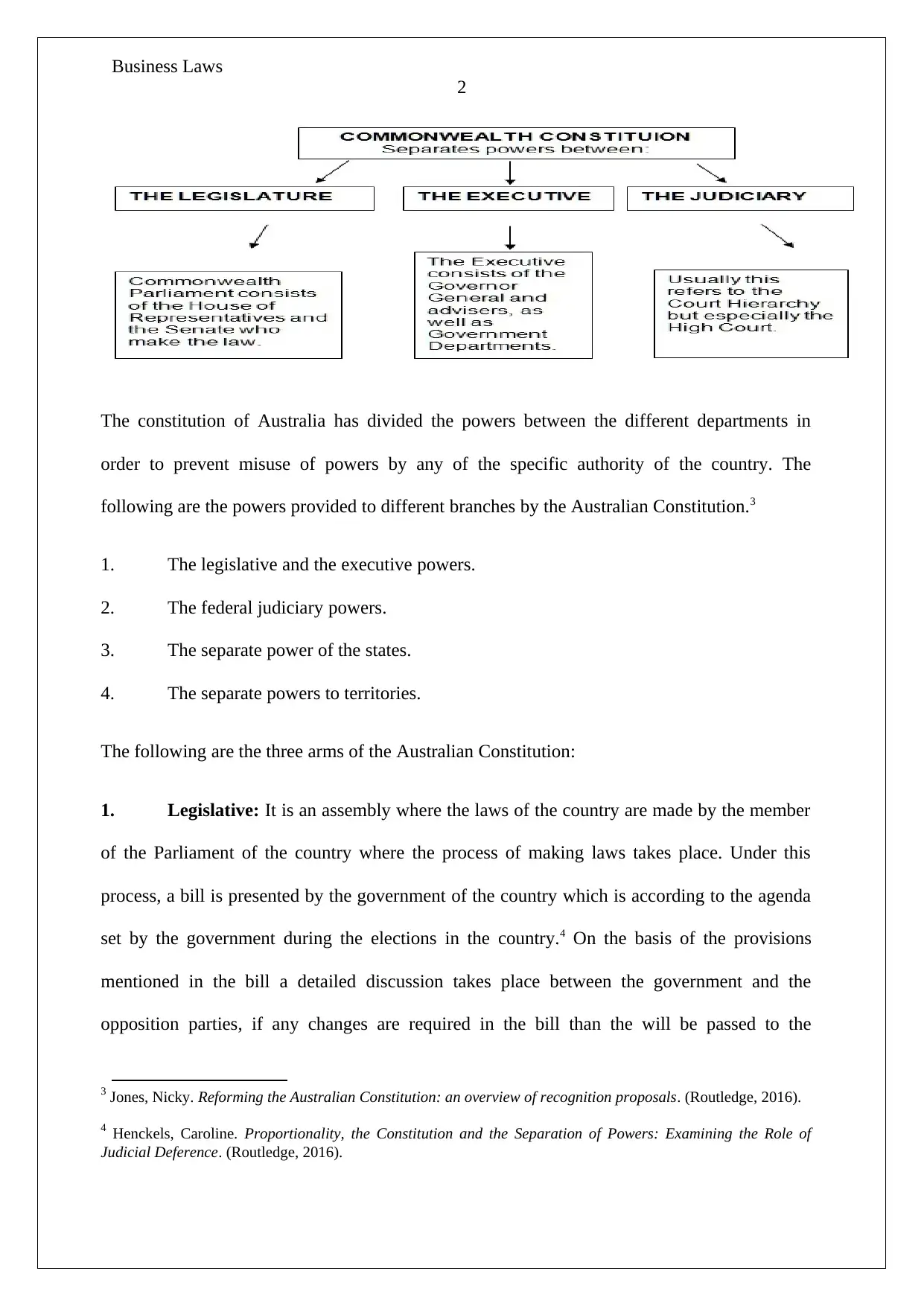
Business Laws
2
The constitution of Australia has divided the powers between the different departments in
order to prevent misuse of powers by any of the specific authority of the country. The
following are the powers provided to different branches by the Australian Constitution.3
1. The legislative and the executive powers.
2. The federal judiciary powers.
3. The separate power of the states.
4. The separate powers to territories.
The following are the three arms of the Australian Constitution:
1. Legislative: It is an assembly where the laws of the country are made by the member
of the Parliament of the country where the process of making laws takes place. Under this
process, a bill is presented by the government of the country which is according to the agenda
set by the government during the elections in the country.4 On the basis of the provisions
mentioned in the bill a detailed discussion takes place between the government and the
opposition parties, if any changes are required in the bill than the will be passed to the
3 Jones, Nicky. Reforming the Australian Constitution: an overview of recognition proposals. (Routledge, 2016).
4 Henckels, Caroline. Proportionality, the Constitution and the Separation of Powers: Examining the Role of
Judicial Deference. (Routledge, 2016).
2
The constitution of Australia has divided the powers between the different departments in
order to prevent misuse of powers by any of the specific authority of the country. The
following are the powers provided to different branches by the Australian Constitution.3
1. The legislative and the executive powers.
2. The federal judiciary powers.
3. The separate power of the states.
4. The separate powers to territories.
The following are the three arms of the Australian Constitution:
1. Legislative: It is an assembly where the laws of the country are made by the member
of the Parliament of the country where the process of making laws takes place. Under this
process, a bill is presented by the government of the country which is according to the agenda
set by the government during the elections in the country.4 On the basis of the provisions
mentioned in the bill a detailed discussion takes place between the government and the
opposition parties, if any changes are required in the bill than the will be passed to the
3 Jones, Nicky. Reforming the Australian Constitution: an overview of recognition proposals. (Routledge, 2016).
4 Henckels, Caroline. Proportionality, the Constitution and the Separation of Powers: Examining the Role of
Judicial Deference. (Routledge, 2016).
⊘ This is a preview!⊘
Do you want full access?
Subscribe today to unlock all pages.

Trusted by 1+ million students worldwide
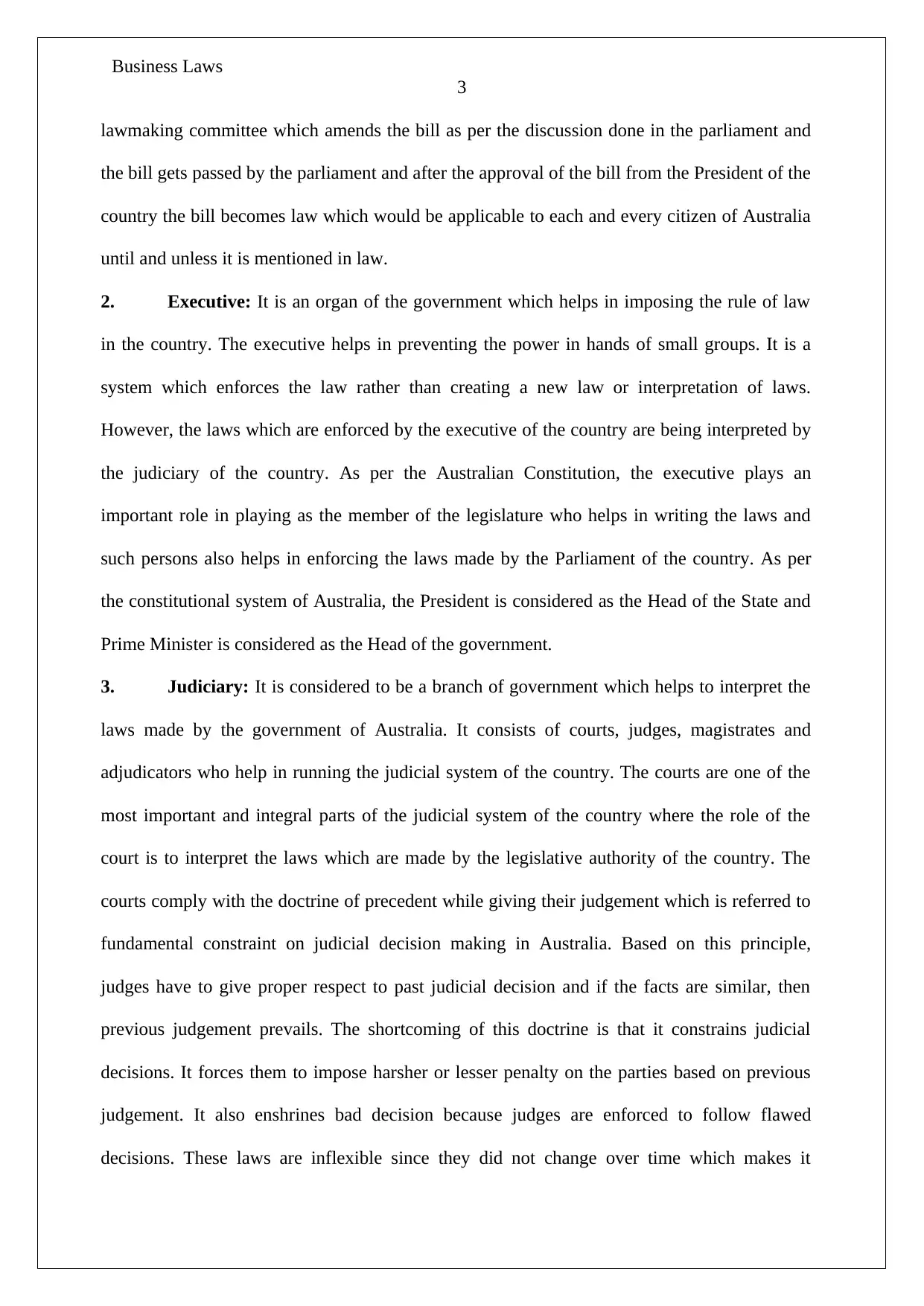
Business Laws
3
lawmaking committee which amends the bill as per the discussion done in the parliament and
the bill gets passed by the parliament and after the approval of the bill from the President of the
country the bill becomes law which would be applicable to each and every citizen of Australia
until and unless it is mentioned in law.
2. Executive: It is an organ of the government which helps in imposing the rule of law
in the country. The executive helps in preventing the power in hands of small groups. It is a
system which enforces the law rather than creating a new law or interpretation of laws.
However, the laws which are enforced by the executive of the country are being interpreted by
the judiciary of the country. As per the Australian Constitution, the executive plays an
important role in playing as the member of the legislature who helps in writing the laws and
such persons also helps in enforcing the laws made by the Parliament of the country. As per
the constitutional system of Australia, the President is considered as the Head of the State and
Prime Minister is considered as the Head of the government.
3. Judiciary: It is considered to be a branch of government which helps to interpret the
laws made by the government of Australia. It consists of courts, judges, magistrates and
adjudicators who help in running the judicial system of the country. The courts are one of the
most important and integral parts of the judicial system of the country where the role of the
court is to interpret the laws which are made by the legislative authority of the country. The
courts comply with the doctrine of precedent while giving their judgement which is referred to
fundamental constraint on judicial decision making in Australia. Based on this principle,
judges have to give proper respect to past judicial decision and if the facts are similar, then
previous judgement prevails. The shortcoming of this doctrine is that it constrains judicial
decisions. It forces them to impose harsher or lesser penalty on the parties based on previous
judgement. It also enshrines bad decision because judges are enforced to follow flawed
decisions. These laws are inflexible since they did not change over time which makes it
3
lawmaking committee which amends the bill as per the discussion done in the parliament and
the bill gets passed by the parliament and after the approval of the bill from the President of the
country the bill becomes law which would be applicable to each and every citizen of Australia
until and unless it is mentioned in law.
2. Executive: It is an organ of the government which helps in imposing the rule of law
in the country. The executive helps in preventing the power in hands of small groups. It is a
system which enforces the law rather than creating a new law or interpretation of laws.
However, the laws which are enforced by the executive of the country are being interpreted by
the judiciary of the country. As per the Australian Constitution, the executive plays an
important role in playing as the member of the legislature who helps in writing the laws and
such persons also helps in enforcing the laws made by the Parliament of the country. As per
the constitutional system of Australia, the President is considered as the Head of the State and
Prime Minister is considered as the Head of the government.
3. Judiciary: It is considered to be a branch of government which helps to interpret the
laws made by the government of Australia. It consists of courts, judges, magistrates and
adjudicators who help in running the judicial system of the country. The courts are one of the
most important and integral parts of the judicial system of the country where the role of the
court is to interpret the laws which are made by the legislative authority of the country. The
courts comply with the doctrine of precedent while giving their judgement which is referred to
fundamental constraint on judicial decision making in Australia. Based on this principle,
judges have to give proper respect to past judicial decision and if the facts are similar, then
previous judgement prevails. The shortcoming of this doctrine is that it constrains judicial
decisions. It forces them to impose harsher or lesser penalty on the parties based on previous
judgement. It also enshrines bad decision because judges are enforced to follow flawed
decisions. These laws are inflexible since they did not change over time which makes it
Paraphrase This Document
Need a fresh take? Get an instant paraphrase of this document with our AI Paraphraser
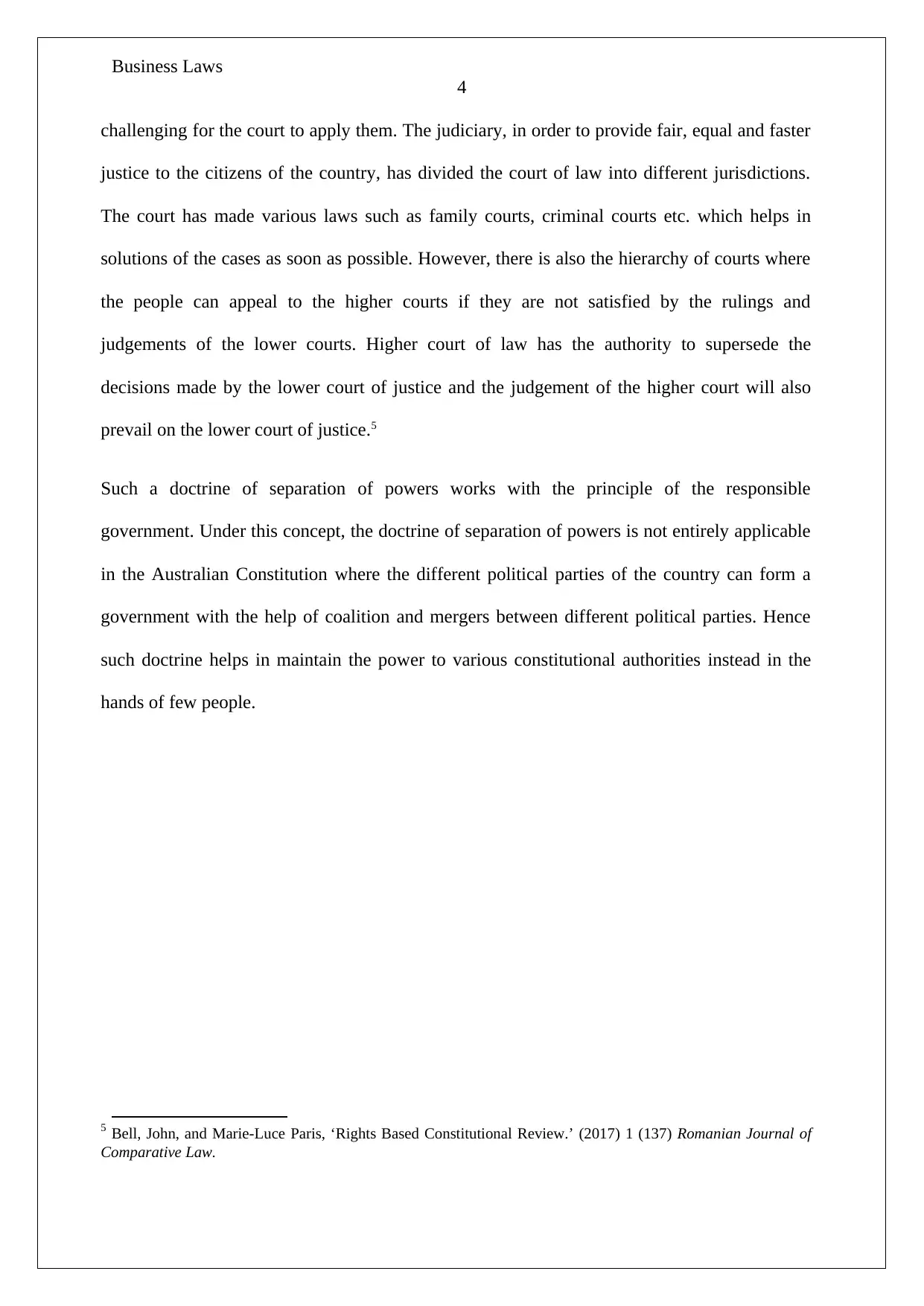
Business Laws
4
challenging for the court to apply them. The judiciary, in order to provide fair, equal and faster
justice to the citizens of the country, has divided the court of law into different jurisdictions.
The court has made various laws such as family courts, criminal courts etc. which helps in
solutions of the cases as soon as possible. However, there is also the hierarchy of courts where
the people can appeal to the higher courts if they are not satisfied by the rulings and
judgements of the lower courts. Higher court of law has the authority to supersede the
decisions made by the lower court of justice and the judgement of the higher court will also
prevail on the lower court of justice.5
Such a doctrine of separation of powers works with the principle of the responsible
government. Under this concept, the doctrine of separation of powers is not entirely applicable
in the Australian Constitution where the different political parties of the country can form a
government with the help of coalition and mergers between different political parties. Hence
such doctrine helps in maintain the power to various constitutional authorities instead in the
hands of few people.
5 Bell, John, and Marie-Luce Paris, ‘Rights Based Constitutional Review.’ (2017) 1 (137) Romanian Journal of
Comparative Law.
4
challenging for the court to apply them. The judiciary, in order to provide fair, equal and faster
justice to the citizens of the country, has divided the court of law into different jurisdictions.
The court has made various laws such as family courts, criminal courts etc. which helps in
solutions of the cases as soon as possible. However, there is also the hierarchy of courts where
the people can appeal to the higher courts if they are not satisfied by the rulings and
judgements of the lower courts. Higher court of law has the authority to supersede the
decisions made by the lower court of justice and the judgement of the higher court will also
prevail on the lower court of justice.5
Such a doctrine of separation of powers works with the principle of the responsible
government. Under this concept, the doctrine of separation of powers is not entirely applicable
in the Australian Constitution where the different political parties of the country can form a
government with the help of coalition and mergers between different political parties. Hence
such doctrine helps in maintain the power to various constitutional authorities instead in the
hands of few people.
5 Bell, John, and Marie-Luce Paris, ‘Rights Based Constitutional Review.’ (2017) 1 (137) Romanian Journal of
Comparative Law.
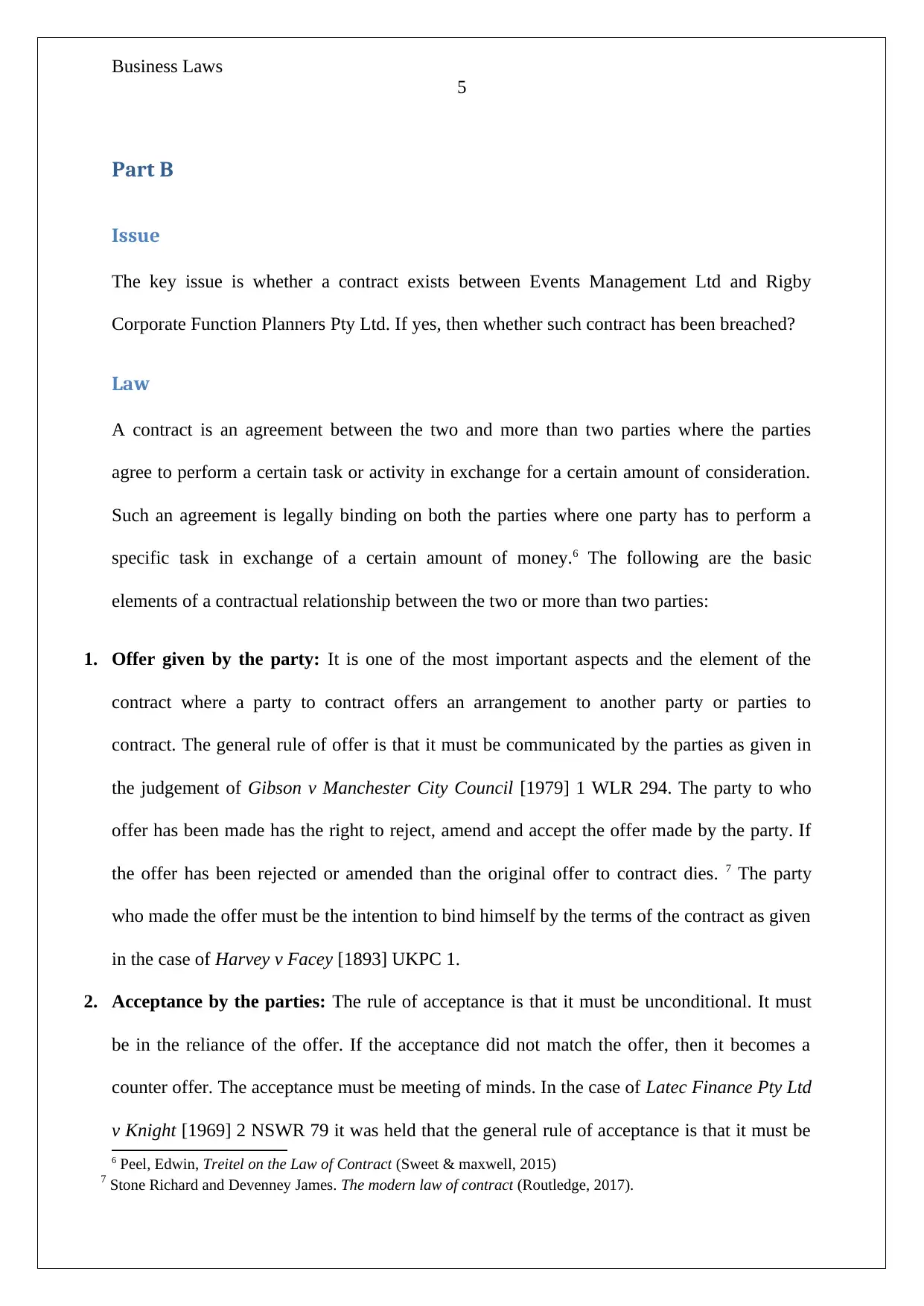
Business Laws
5
Part B
Issue
The key issue is whether a contract exists between Events Management Ltd and Rigby
Corporate Function Planners Pty Ltd. If yes, then whether such contract has been breached?
Law
A contract is an agreement between the two and more than two parties where the parties
agree to perform a certain task or activity in exchange for a certain amount of consideration.
Such an agreement is legally binding on both the parties where one party has to perform a
specific task in exchange of a certain amount of money.6 The following are the basic
elements of a contractual relationship between the two or more than two parties:
1. Offer given by the party: It is one of the most important aspects and the element of the
contract where a party to contract offers an arrangement to another party or parties to
contract. The general rule of offer is that it must be communicated by the parties as given in
the judgement of Gibson v Manchester City Council [1979] 1 WLR 294. The party to who
offer has been made has the right to reject, amend and accept the offer made by the party. If
the offer has been rejected or amended than the original offer to contract dies. 7 The party
who made the offer must be the intention to bind himself by the terms of the contract as given
in the case of Harvey v Facey [1893] UKPC 1.
2. Acceptance by the parties: The rule of acceptance is that it must be unconditional. It must
be in the reliance of the offer. If the acceptance did not match the offer, then it becomes a
counter offer. The acceptance must be meeting of minds. In the case of Latec Finance Pty Ltd
v Knight [1969] 2 NSWR 79 it was held that the general rule of acceptance is that it must be
6 Peel, Edwin, Treitel on the Law of Contract (Sweet & maxwell, 2015)
7 Stone Richard and Devenney James. The modern law of contract (Routledge, 2017).
5
Part B
Issue
The key issue is whether a contract exists between Events Management Ltd and Rigby
Corporate Function Planners Pty Ltd. If yes, then whether such contract has been breached?
Law
A contract is an agreement between the two and more than two parties where the parties
agree to perform a certain task or activity in exchange for a certain amount of consideration.
Such an agreement is legally binding on both the parties where one party has to perform a
specific task in exchange of a certain amount of money.6 The following are the basic
elements of a contractual relationship between the two or more than two parties:
1. Offer given by the party: It is one of the most important aspects and the element of the
contract where a party to contract offers an arrangement to another party or parties to
contract. The general rule of offer is that it must be communicated by the parties as given in
the judgement of Gibson v Manchester City Council [1979] 1 WLR 294. The party to who
offer has been made has the right to reject, amend and accept the offer made by the party. If
the offer has been rejected or amended than the original offer to contract dies. 7 The party
who made the offer must be the intention to bind himself by the terms of the contract as given
in the case of Harvey v Facey [1893] UKPC 1.
2. Acceptance by the parties: The rule of acceptance is that it must be unconditional. It must
be in the reliance of the offer. If the acceptance did not match the offer, then it becomes a
counter offer. The acceptance must be meeting of minds. In the case of Latec Finance Pty Ltd
v Knight [1969] 2 NSWR 79 it was held that the general rule of acceptance is that it must be
6 Peel, Edwin, Treitel on the Law of Contract (Sweet & maxwell, 2015)
7 Stone Richard and Devenney James. The modern law of contract (Routledge, 2017).
⊘ This is a preview!⊘
Do you want full access?
Subscribe today to unlock all pages.

Trusted by 1+ million students worldwide
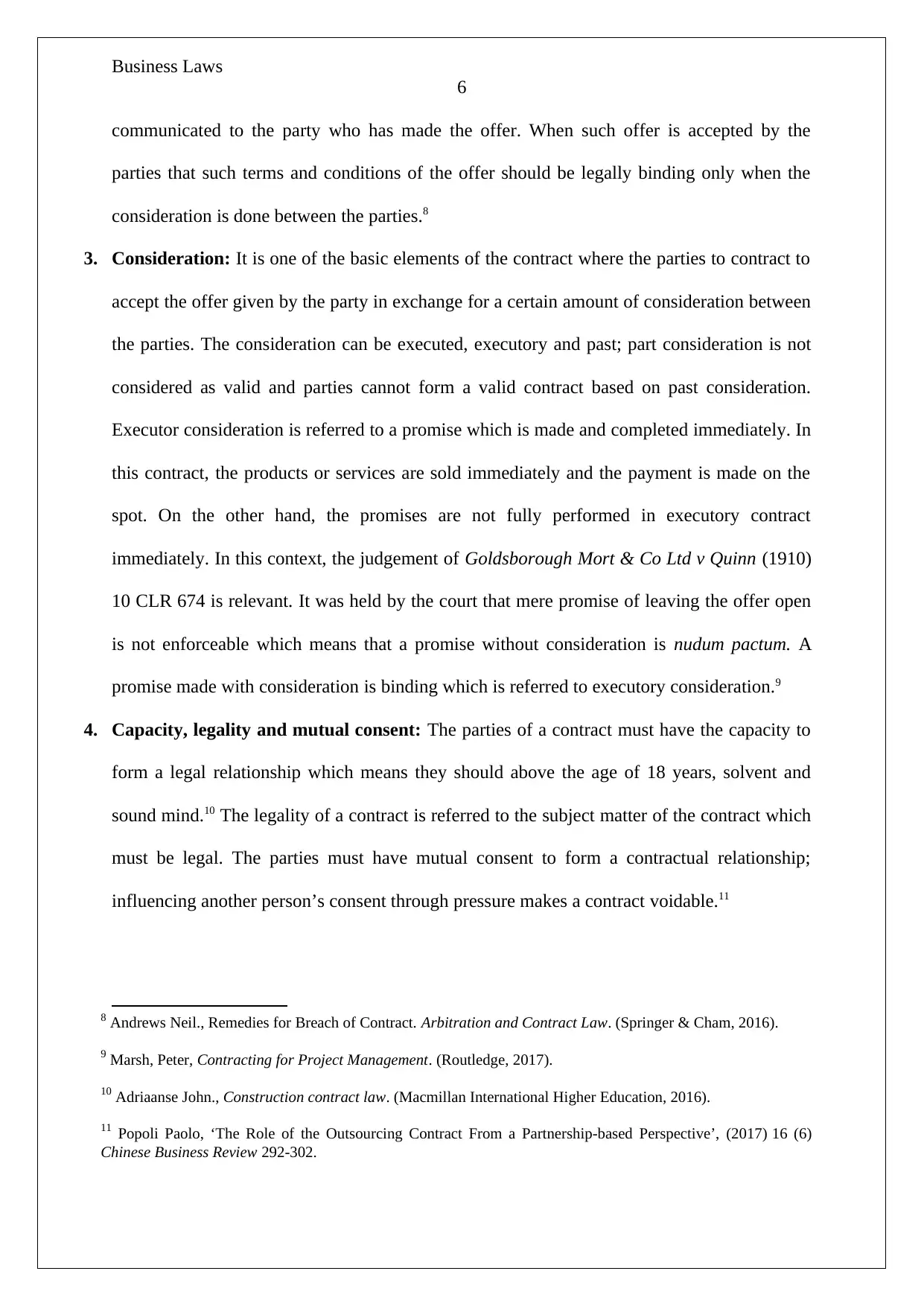
Business Laws
6
communicated to the party who has made the offer. When such offer is accepted by the
parties that such terms and conditions of the offer should be legally binding only when the
consideration is done between the parties.8
3. Consideration: It is one of the basic elements of the contract where the parties to contract to
accept the offer given by the party in exchange for a certain amount of consideration between
the parties. The consideration can be executed, executory and past; part consideration is not
considered as valid and parties cannot form a valid contract based on past consideration.
Executor consideration is referred to a promise which is made and completed immediately. In
this contract, the products or services are sold immediately and the payment is made on the
spot. On the other hand, the promises are not fully performed in executory contract
immediately. In this context, the judgement of Goldsborough Mort & Co Ltd v Quinn (1910)
10 CLR 674 is relevant. It was held by the court that mere promise of leaving the offer open
is not enforceable which means that a promise without consideration is nudum pactum. A
promise made with consideration is binding which is referred to executory consideration.9
4. Capacity, legality and mutual consent: The parties of a contract must have the capacity to
form a legal relationship which means they should above the age of 18 years, solvent and
sound mind.10 The legality of a contract is referred to the subject matter of the contract which
must be legal. The parties must have mutual consent to form a contractual relationship;
influencing another person’s consent through pressure makes a contract voidable.11
8 Andrews Neil., Remedies for Breach of Contract. Arbitration and Contract Law. (Springer & Cham, 2016).
9 Marsh, Peter, Contracting for Project Management. (Routledge, 2017).
10 Adriaanse John., Construction contract law. (Macmillan International Higher Education, 2016).
11 Popoli Paolo, ‘The Role of the Outsourcing Contract From a Partnership-based Perspective’, (2017) 16 (6)
Chinese Business Review 292-302.
6
communicated to the party who has made the offer. When such offer is accepted by the
parties that such terms and conditions of the offer should be legally binding only when the
consideration is done between the parties.8
3. Consideration: It is one of the basic elements of the contract where the parties to contract to
accept the offer given by the party in exchange for a certain amount of consideration between
the parties. The consideration can be executed, executory and past; part consideration is not
considered as valid and parties cannot form a valid contract based on past consideration.
Executor consideration is referred to a promise which is made and completed immediately. In
this contract, the products or services are sold immediately and the payment is made on the
spot. On the other hand, the promises are not fully performed in executory contract
immediately. In this context, the judgement of Goldsborough Mort & Co Ltd v Quinn (1910)
10 CLR 674 is relevant. It was held by the court that mere promise of leaving the offer open
is not enforceable which means that a promise without consideration is nudum pactum. A
promise made with consideration is binding which is referred to executory consideration.9
4. Capacity, legality and mutual consent: The parties of a contract must have the capacity to
form a legal relationship which means they should above the age of 18 years, solvent and
sound mind.10 The legality of a contract is referred to the subject matter of the contract which
must be legal. The parties must have mutual consent to form a contractual relationship;
influencing another person’s consent through pressure makes a contract voidable.11
8 Andrews Neil., Remedies for Breach of Contract. Arbitration and Contract Law. (Springer & Cham, 2016).
9 Marsh, Peter, Contracting for Project Management. (Routledge, 2017).
10 Adriaanse John., Construction contract law. (Macmillan International Higher Education, 2016).
11 Popoli Paolo, ‘The Role of the Outsourcing Contract From a Partnership-based Perspective’, (2017) 16 (6)
Chinese Business Review 292-302.
Paraphrase This Document
Need a fresh take? Get an instant paraphrase of this document with our AI Paraphraser
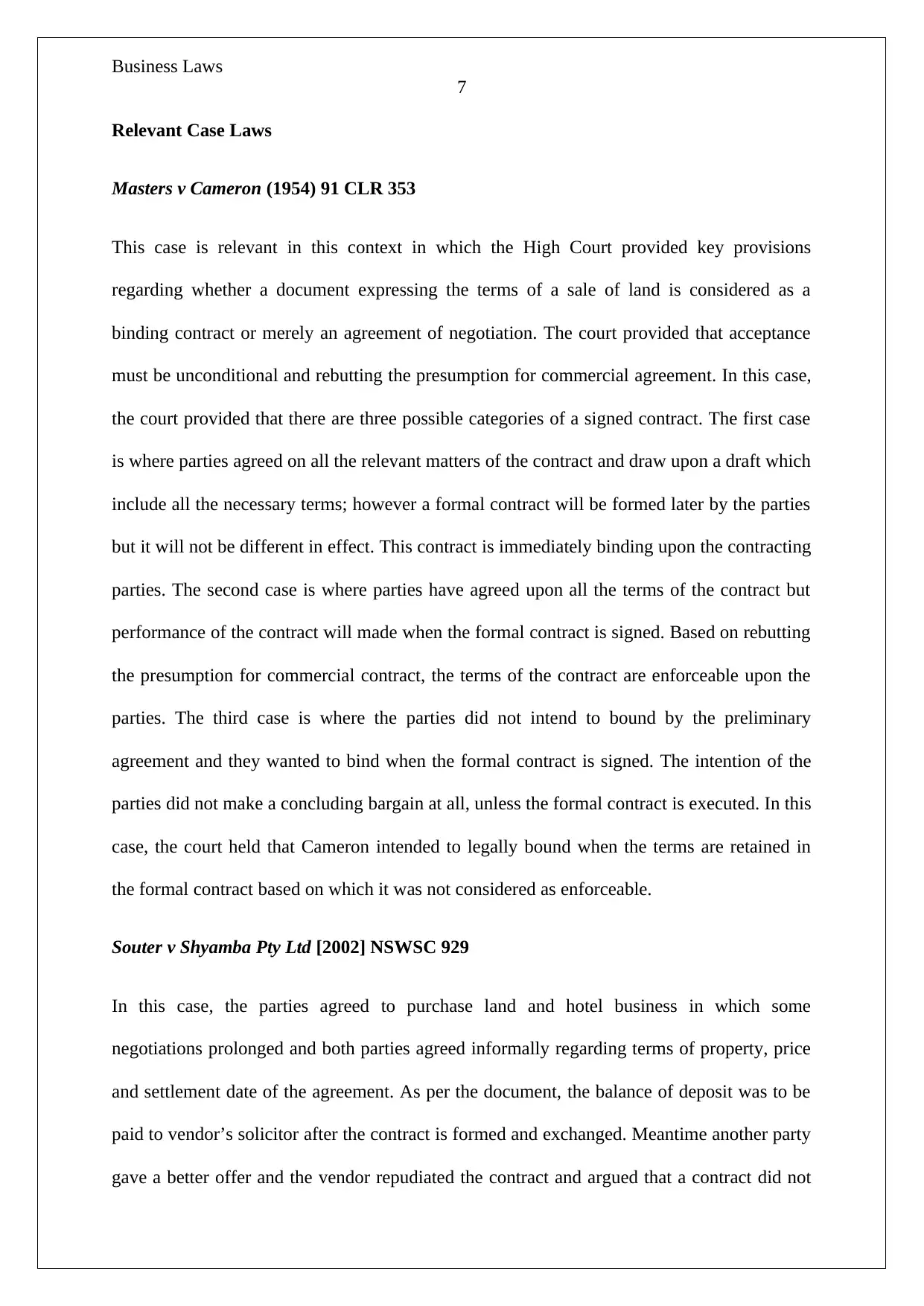
Business Laws
7
Relevant Case Laws
Masters v Cameron (1954) 91 CLR 353
This case is relevant in this context in which the High Court provided key provisions
regarding whether a document expressing the terms of a sale of land is considered as a
binding contract or merely an agreement of negotiation. The court provided that acceptance
must be unconditional and rebutting the presumption for commercial agreement. In this case,
the court provided that there are three possible categories of a signed contract. The first case
is where parties agreed on all the relevant matters of the contract and draw upon a draft which
include all the necessary terms; however a formal contract will be formed later by the parties
but it will not be different in effect. This contract is immediately binding upon the contracting
parties. The second case is where parties have agreed upon all the terms of the contract but
performance of the contract will made when the formal contract is signed. Based on rebutting
the presumption for commercial contract, the terms of the contract are enforceable upon the
parties. The third case is where the parties did not intend to bound by the preliminary
agreement and they wanted to bind when the formal contract is signed. The intention of the
parties did not make a concluding bargain at all, unless the formal contract is executed. In this
case, the court held that Cameron intended to legally bound when the terms are retained in
the formal contract based on which it was not considered as enforceable.
Souter v Shyamba Pty Ltd [2002] NSWSC 929
In this case, the parties agreed to purchase land and hotel business in which some
negotiations prolonged and both parties agreed informally regarding terms of property, price
and settlement date of the agreement. As per the document, the balance of deposit was to be
paid to vendor’s solicitor after the contract is formed and exchanged. Meantime another party
gave a better offer and the vendor repudiated the contract and argued that a contract did not
7
Relevant Case Laws
Masters v Cameron (1954) 91 CLR 353
This case is relevant in this context in which the High Court provided key provisions
regarding whether a document expressing the terms of a sale of land is considered as a
binding contract or merely an agreement of negotiation. The court provided that acceptance
must be unconditional and rebutting the presumption for commercial agreement. In this case,
the court provided that there are three possible categories of a signed contract. The first case
is where parties agreed on all the relevant matters of the contract and draw upon a draft which
include all the necessary terms; however a formal contract will be formed later by the parties
but it will not be different in effect. This contract is immediately binding upon the contracting
parties. The second case is where parties have agreed upon all the terms of the contract but
performance of the contract will made when the formal contract is signed. Based on rebutting
the presumption for commercial contract, the terms of the contract are enforceable upon the
parties. The third case is where the parties did not intend to bound by the preliminary
agreement and they wanted to bind when the formal contract is signed. The intention of the
parties did not make a concluding bargain at all, unless the formal contract is executed. In this
case, the court held that Cameron intended to legally bound when the terms are retained in
the formal contract based on which it was not considered as enforceable.
Souter v Shyamba Pty Ltd [2002] NSWSC 929
In this case, the parties agreed to purchase land and hotel business in which some
negotiations prolonged and both parties agreed informally regarding terms of property, price
and settlement date of the agreement. As per the document, the balance of deposit was to be
paid to vendor’s solicitor after the contract is formed and exchanged. Meantime another party
gave a better offer and the vendor repudiated the contract and argued that a contract did not

Business Laws
8
exist between parties. The court provided that the original offer is immediately binding on the
parties and it is legally enforceable.
8
exist between parties. The court provided that the original offer is immediately binding on the
parties and it is legally enforceable.
⊘ This is a preview!⊘
Do you want full access?
Subscribe today to unlock all pages.

Trusted by 1+ million students worldwide
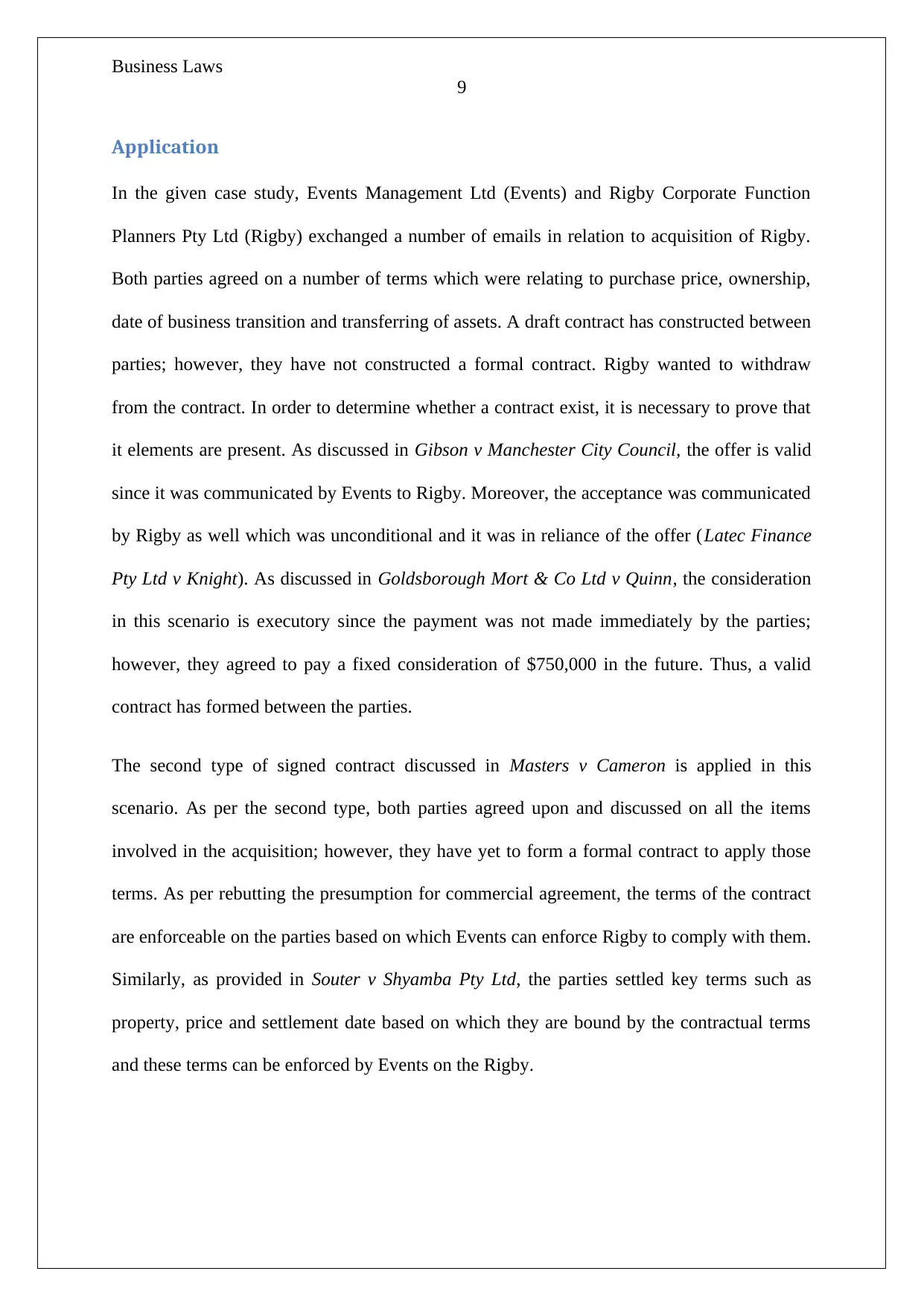
Business Laws
9
Application
In the given case study, Events Management Ltd (Events) and Rigby Corporate Function
Planners Pty Ltd (Rigby) exchanged a number of emails in relation to acquisition of Rigby.
Both parties agreed on a number of terms which were relating to purchase price, ownership,
date of business transition and transferring of assets. A draft contract has constructed between
parties; however, they have not constructed a formal contract. Rigby wanted to withdraw
from the contract. In order to determine whether a contract exist, it is necessary to prove that
it elements are present. As discussed in Gibson v Manchester City Council, the offer is valid
since it was communicated by Events to Rigby. Moreover, the acceptance was communicated
by Rigby as well which was unconditional and it was in reliance of the offer (Latec Finance
Pty Ltd v Knight). As discussed in Goldsborough Mort & Co Ltd v Quinn, the consideration
in this scenario is executory since the payment was not made immediately by the parties;
however, they agreed to pay a fixed consideration of $750,000 in the future. Thus, a valid
contract has formed between the parties.
The second type of signed contract discussed in Masters v Cameron is applied in this
scenario. As per the second type, both parties agreed upon and discussed on all the items
involved in the acquisition; however, they have yet to form a formal contract to apply those
terms. As per rebutting the presumption for commercial agreement, the terms of the contract
are enforceable on the parties based on which Events can enforce Rigby to comply with them.
Similarly, as provided in Souter v Shyamba Pty Ltd, the parties settled key terms such as
property, price and settlement date based on which they are bound by the contractual terms
and these terms can be enforced by Events on the Rigby.
9
Application
In the given case study, Events Management Ltd (Events) and Rigby Corporate Function
Planners Pty Ltd (Rigby) exchanged a number of emails in relation to acquisition of Rigby.
Both parties agreed on a number of terms which were relating to purchase price, ownership,
date of business transition and transferring of assets. A draft contract has constructed between
parties; however, they have not constructed a formal contract. Rigby wanted to withdraw
from the contract. In order to determine whether a contract exist, it is necessary to prove that
it elements are present. As discussed in Gibson v Manchester City Council, the offer is valid
since it was communicated by Events to Rigby. Moreover, the acceptance was communicated
by Rigby as well which was unconditional and it was in reliance of the offer (Latec Finance
Pty Ltd v Knight). As discussed in Goldsborough Mort & Co Ltd v Quinn, the consideration
in this scenario is executory since the payment was not made immediately by the parties;
however, they agreed to pay a fixed consideration of $750,000 in the future. Thus, a valid
contract has formed between the parties.
The second type of signed contract discussed in Masters v Cameron is applied in this
scenario. As per the second type, both parties agreed upon and discussed on all the items
involved in the acquisition; however, they have yet to form a formal contract to apply those
terms. As per rebutting the presumption for commercial agreement, the terms of the contract
are enforceable on the parties based on which Events can enforce Rigby to comply with them.
Similarly, as provided in Souter v Shyamba Pty Ltd, the parties settled key terms such as
property, price and settlement date based on which they are bound by the contractual terms
and these terms can be enforced by Events on the Rigby.
Paraphrase This Document
Need a fresh take? Get an instant paraphrase of this document with our AI Paraphraser

Business Laws
10
Conclusion
As per from the above case study it can be advised to Samantha that a contract has formed
between Events and Rigby and this contract was breached. Hence it can be recommended to
Samantha that Events can enforce the terms on Rigby based on rebutting the presumption for
commercial agreement.
10
Conclusion
As per from the above case study it can be advised to Samantha that a contract has formed
between Events and Rigby and this contract was breached. Hence it can be recommended to
Samantha that Events can enforce the terms on Rigby based on rebutting the presumption for
commercial agreement.
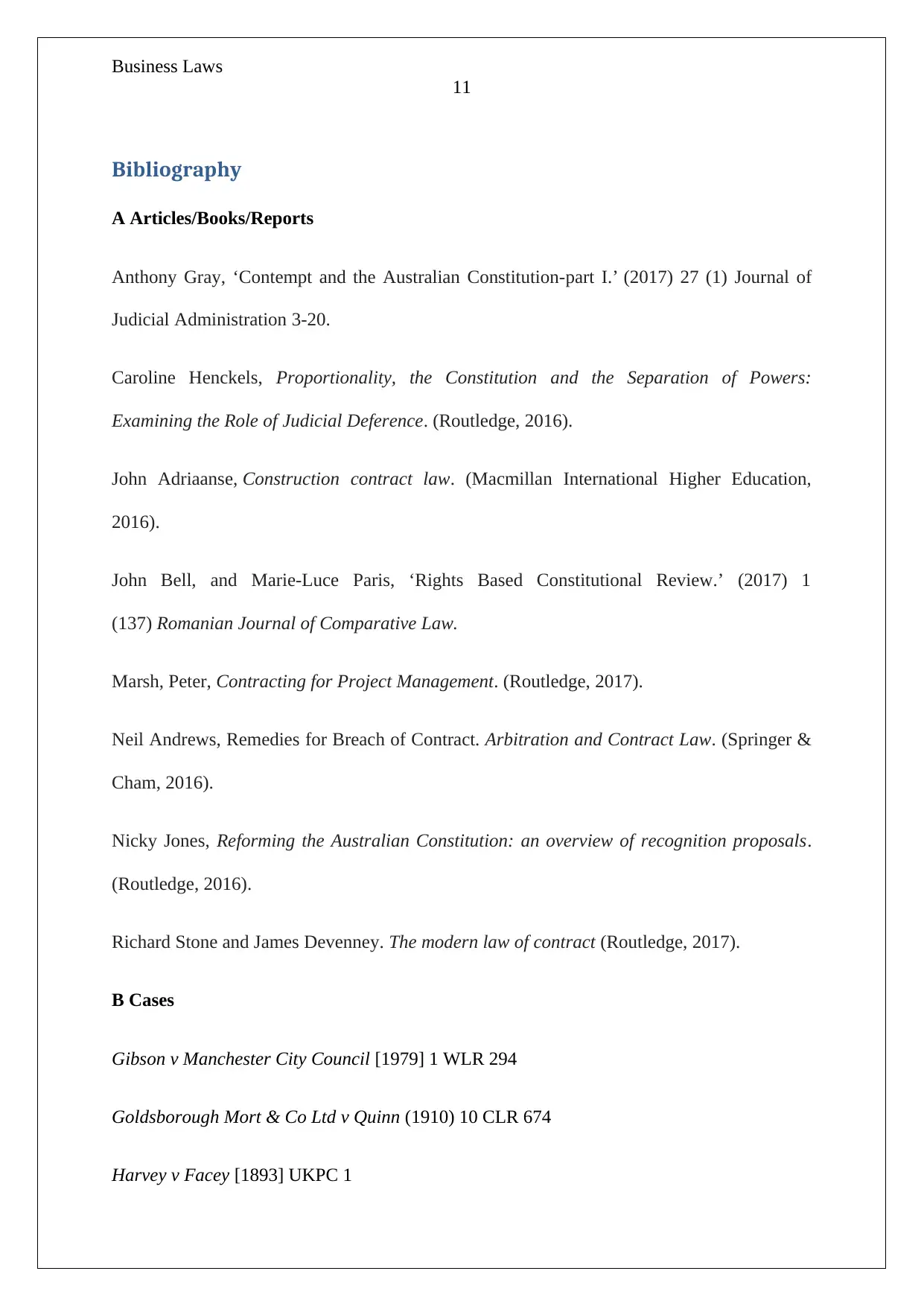
Business Laws
11
Bibliography
A Articles/Books/Reports
Anthony Gray, ‘Contempt and the Australian Constitution-part I.’ (2017) 27 (1) Journal of
Judicial Administration 3-20.
Caroline Henckels, Proportionality, the Constitution and the Separation of Powers:
Examining the Role of Judicial Deference. (Routledge, 2016).
John Adriaanse, Construction contract law. (Macmillan International Higher Education,
2016).
John Bell, and Marie-Luce Paris, ‘Rights Based Constitutional Review.’ (2017) 1
(137) Romanian Journal of Comparative Law.
Marsh, Peter, Contracting for Project Management. (Routledge, 2017).
Neil Andrews, Remedies for Breach of Contract. Arbitration and Contract Law. (Springer &
Cham, 2016).
Nicky Jones, Reforming the Australian Constitution: an overview of recognition proposals.
(Routledge, 2016).
Richard Stone and James Devenney. The modern law of contract (Routledge, 2017).
B Cases
Gibson v Manchester City Council [1979] 1 WLR 294
Goldsborough Mort & Co Ltd v Quinn (1910) 10 CLR 674
Harvey v Facey [1893] UKPC 1
11
Bibliography
A Articles/Books/Reports
Anthony Gray, ‘Contempt and the Australian Constitution-part I.’ (2017) 27 (1) Journal of
Judicial Administration 3-20.
Caroline Henckels, Proportionality, the Constitution and the Separation of Powers:
Examining the Role of Judicial Deference. (Routledge, 2016).
John Adriaanse, Construction contract law. (Macmillan International Higher Education,
2016).
John Bell, and Marie-Luce Paris, ‘Rights Based Constitutional Review.’ (2017) 1
(137) Romanian Journal of Comparative Law.
Marsh, Peter, Contracting for Project Management. (Routledge, 2017).
Neil Andrews, Remedies for Breach of Contract. Arbitration and Contract Law. (Springer &
Cham, 2016).
Nicky Jones, Reforming the Australian Constitution: an overview of recognition proposals.
(Routledge, 2016).
Richard Stone and James Devenney. The modern law of contract (Routledge, 2017).
B Cases
Gibson v Manchester City Council [1979] 1 WLR 294
Goldsborough Mort & Co Ltd v Quinn (1910) 10 CLR 674
Harvey v Facey [1893] UKPC 1
⊘ This is a preview!⊘
Do you want full access?
Subscribe today to unlock all pages.

Trusted by 1+ million students worldwide
1 out of 13
Related Documents
Your All-in-One AI-Powered Toolkit for Academic Success.
+13062052269
info@desklib.com
Available 24*7 on WhatsApp / Email
![[object Object]](/_next/static/media/star-bottom.7253800d.svg)
Unlock your academic potential
Copyright © 2020–2025 A2Z Services. All Rights Reserved. Developed and managed by ZUCOL.





